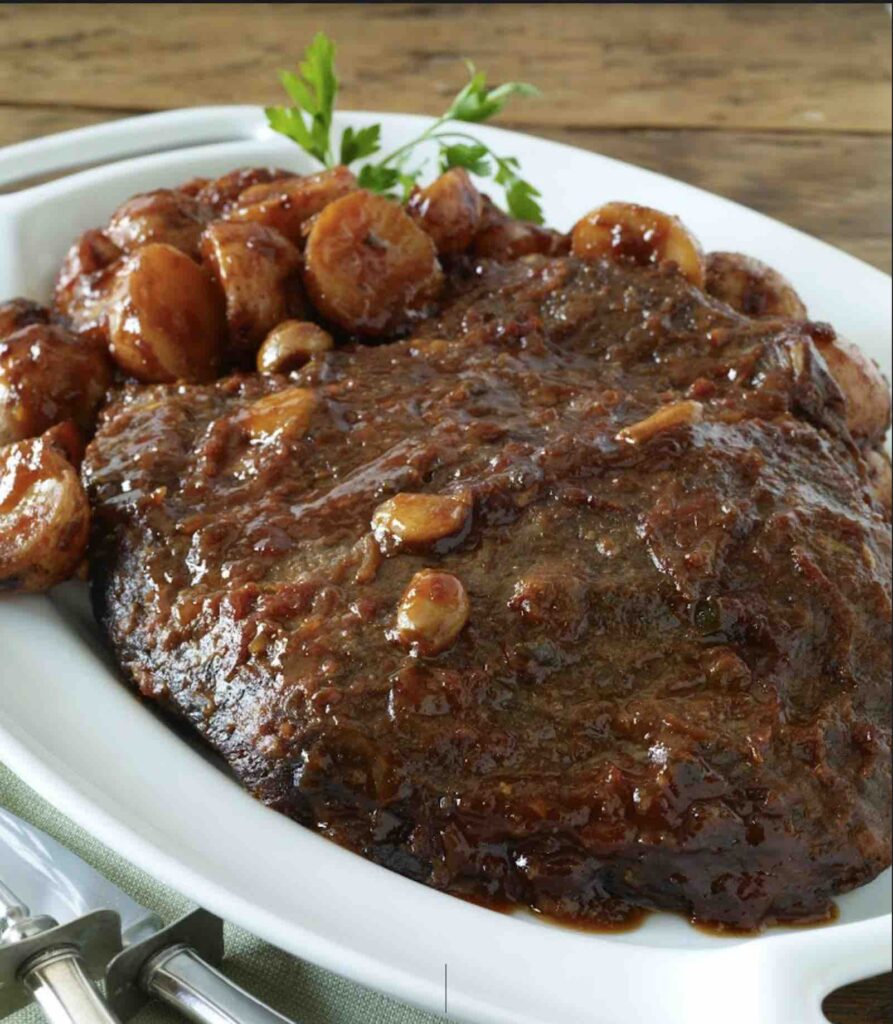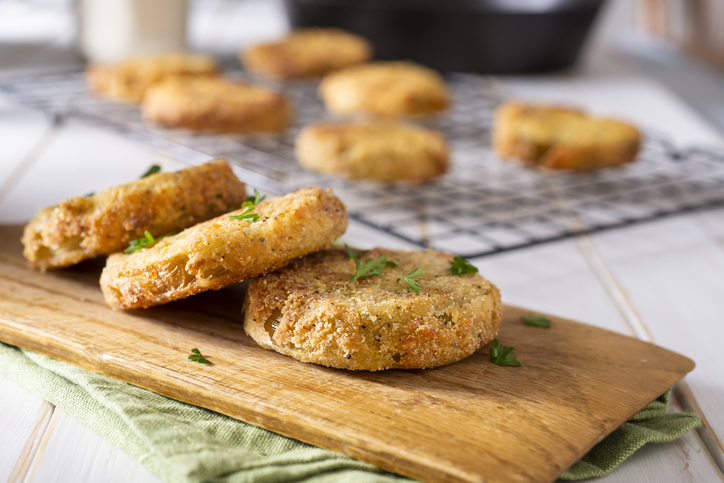
PHOTO COURTESY OF JON EDWARDS
There’s more to fry than latkes
Hanukkah is all about the oil. When Judah Maccabee and his tiny army defeated the Syrian-Greeks, they found only a tiny flask of oil with which to purify the desecrated Temple. Miraculously, it burned for eight days, setting off a frying frenzy that has lasted for centuries.
But who says traditional potato latkes are the only fritters fit to fry?
I’ve just returned from Charleston, South Carolina, a great Southern food city where frying is an art form. Fried green tomatoes are ubiquitous there, and it got me thinking, what a unique idea for Hanukkah. I’m not suggesting you give up latkes, heaven forbid.
But this holiday, you’ll remember, is all about the oil, not the potato, so why not add something new to your repertoire?
My trip to Charleston was a learning adventure with Road Scholar, the nonprofit educational travel organization for seniors (roadscholar.org). They do an excellent job of providing knowledgeable lecturers and tour guides, and Charleston was the perfect place, not only to taste delicious Southern food, but to learn some of our nation’s history, seamy side and all.
My friend Joanne Rocklin and I arrived a day early so we could tour Kahal Kadosh Beth Elohim (Holy Congregation House of God), the second oldest synagogue building in the United States and the oldest in continuous use. It was designated a National Historic Landmark in 1980.
The first written mention of a Jew in Charleston dates to 1695, 25 years after the establishment of the settlement. Attracted by economic opportunity and South Carolina’s civil and religious liberty, other Jews followed, and by 1749 the present congregation was organized. Coming Street Cemetery, the oldest surviving Jewish burial ground in the South, was established 15 years later.
By the time George Washington became president, Jewish congregations had been established in six cities in the new nation: Newport, Rhode Island; New York; Philadelphia; Charleston, South Carolina; Richmond, Virginia; and Savannah, Georgia.
Charleston’s Hebrew Benevolent Society, the country’s oldest Jewish charitable organization, was founded in 1784 by members of the congregation, who also established the Hebrew Orphan Society, the country’s oldest as well, in 1801. Both still function today. Members of the congregation also organized the second oldest Jewish religious school in the United States in 1838.
“Food is a lens on the South Carolina Jewish experience,” write co-authors Rachel Gordin Barnett and Lyssa Kligman Harvey in “Kugels & Collards: Stories of Food, Family and Tradition in Jewish South Carolina” (University of South Carolina Press, $33.29.)
“Our inspiration to create ‘Kugels & Collards’ came from our mothers and grandmothers, descendants of Eastern European and Sephardic immigrants, as well as the African American women who worked in our homes as housekeepers and cooks and share their culinary knowledge. What we consider ‘typical Southern fare’ reveals the culinary legacy of Africans brought against their will to the American South centuries ago. On South Carolina Jewish tables, it is not unusual to have African American staples such as collard greens, black-eyed peas and rice, alongside European Jewish dishes such as brisket, tsimmes and kugel. The aromas, textures, and taste of these meals made their way into the homes of our immigrant grandparents through generations of Black South Carolinians working in their traditional Jewish kitchens.”
Recipes in “Kugels & Collards” illustrate this merging of cultures. You’ll find biscuits as well as challah, chopped liver and fried chicken, farfel souffle and fried green tomatoes, gefilte fish and salmon and grits. The latter recipe comes from Hyman’s Seafood, a Charleston institution, where we enjoyed a delightful lunch. Salmon and grits was created as a riff on Southern shrimp and grits for customers who do not eat shellfish.
In 1987 Aaron Hyman opened Aaron’s Deli and brother Eli Hyman opened Hyman’s Seafood at the Meeting Street location where their great grandfather, Wolf Maier Karesh, a Jewish immigrant from Eastern Europe, had founded Southern Wholesale in 1890.
Aaron had lived in Israel and had worked in kitchens both there and in South Carolina. Aaron’s Deli became known for New York deli-style food like pastrami, corned beef, salami, etc., as well as for Southern dishes like collard greens, okra gumbo and fried chicken. Hyman’s Seafood soon became famous for its fried green tomatoes, hush puppies, boiled peanuts, and fried seafood platters. In fact, our meal began with their iconic fried green tomatoes as an appetizer, this time served over creamy grits and topped with a Parmesan cream sauce and cheddar cheese, a dish they call Wadmalaw Delight. (Wadmalaw is a small island just south of Charleston.)
“Now the sole owner of the establishments, Eli continues to run his business with a basis in his strong Jewish values and education,” writes co-author Lyssa Kligman Harvey. “Chief among those values is sharing with others.” After hurricane Hugo devastated the city in 1989, the brothers provided 300 to 500 free meals a day to those in need. Eli has continued to serve free lunches to the needy. “Eli says,” writes Harvey, “Our restaurant is a place where people gather, eat, laugh, share ideas, and make memories.’’
Sometimes I find recipes in surprising places. Leafing through a gorgeous coffee table book in one of the gift shops we visited, I found another recipe that would be perfect for Hanukkah. This stunningly illustrated cook’s tour through the Lowcountry of coastal South Carolina, “Shrimp, Collards & Grits” (Lydia Inglett Ltd., $49.95) by Pat Browning with artwork by Nancy Ricker Rhett, despite the treif in the title, contained an interesting brisket recipe, one infused with beer and bourbon and smothered in a bourbon-peach glaze, a woozy braise that practically leaps out of the pan and exclaims, “L’Chaim!” While the photo of the brisket in the cookbook shows it shredded in a sandwich, it certainly can be served sliced for an elegant holiday meal.
Braised Brisket with Bourbon-Peach Glaze
Yield: 8-10 servings
Sweet and Salty Dry Rub
1/3 cup ground good quality paprika
2 tablespoons freshly ground black pepper
2 tablespoons sea salt
2 tablespoons unpacked light brown sugar
1 tablespoon crushed red pepper flakes
1 tablespoon Colemans’s dry mustard
Peach glaze
1/2 cup peach jam
2 teaspoons bourbon
Kosher salt and freshly ground black pepper
1/4 cup braising liquid
1 (four-pound) brisket with thin layer of fat on top, patted dry
2 tablespoons oil, divided
3/4 cup chopped onion
4 cloves garlic, minced
4 cups beef broth
One (12 ounce) bottle beer
3/4 cup bourbon
1/4 cup brown sugar
1/4 cup soy sauce
Several sprigs fresh thyme
3 stalks celery, chopped
1 tablespoon balsamic vinegar
1. Mix dry rub ingredients together in small bowl. Rub brisket all over with about 3 tablespoons mixture. Store remainder in glass jar.
2. Preheat oven to 350°F. Heat 1 tablespoon oil in large, heavy oven-proof pot, and place brisket, fat side down into pot. Cook over medium-high heat until well browned. Turn brisket over and brown another five minutes on the other side. Remove brisket from pot.
3. Reduce heat and add remaining tablespoon oil. Add onion and garlic. Cook, stirring occasionally, until onion is slightly golden, about 5 minutes. Add broth and remaining ingredients. Bring liquid to a simmer and place brisket back in pot, fat side up. Cover and transfer to oven. Braise brisket until tender, about 4 to 5 hours. Score fat side of brisket by cutting a cross-hatch pattern of 1/4 inch deep slits spaced 1/2 inch apart.
4. Return brisket, fat side up, to pot with braising liquid.
5. Meanwhile, puree glaze ingredients until smooth. When brisket is cooked, cover with glaze and broil 5 more minutes. Slice and serve.
Hyman’s Fried Green Tomatoes
4 cups milk
4 large eggs
4 large green tomatoes
1 cup flour
1/2 cup cornmeal
1 1/2 cups vegetable oil (add more if necessary)
1. Beat milk and eggs together in large bowl. Slice tomatoes thick so they won’t become soggy when fried.
2. Mix flour and cornmeal together, and drop tomato slices into the mixture until they are covered. Dip breaded tomatoes into milk and egg mixture. Dip in breading again and let sit for 30 minutes.
3. Pan fry until golden brown.
Yield: approximately 16 pieces.
Jlife Food Editor Judy Bart Kancigor is the author of “Cooking Jewish” (Workman) and “The Perfect Passover Cookbook” (an e-book short from Workman), a columnist and feature writer for the Orange County Register and other publications and can be found on the web at www.cookingjewish.com.







